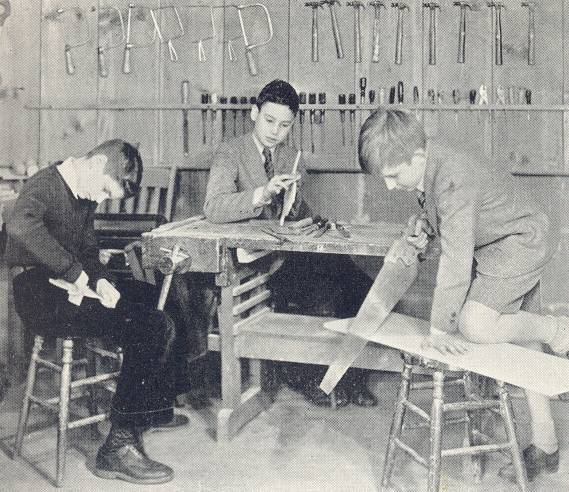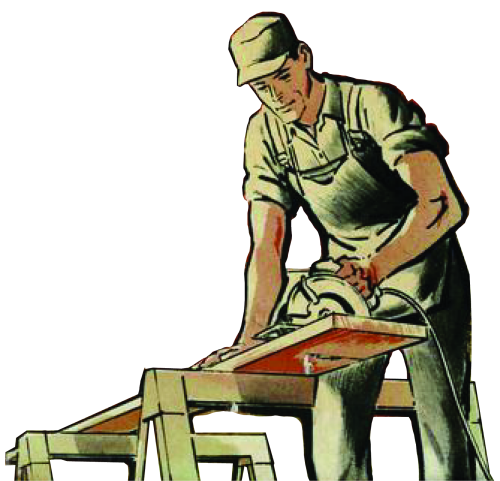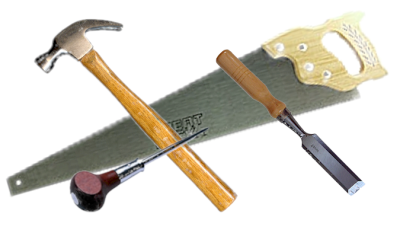|
|
|
| Preface This is an article I ran into long ago, way way before the internet. It is presented here because this isn't all that accessable otherwise. |
| How
to Make a Board |
Most of what I know about carpentry, which is almost nothing, I learned in shop. I took shop during the Eisenhower administration, when boys took shop and girls took home economics, a code name for "cooking". Schools are not allowed to separate boys and girls like that any more. They're also not allowed to put students' heads in vises and tighten them, which is what our shop teacher, Mr. Schmidt, did to Ronnie Miller in the fifth grade when Ronnie used a chisel when he should have used a screwdriver. (Mr. Schmidt had strong feelings about how to use tools properly.) I guess he shouldn't have put Ronnie's head in the vise, but it (Ronnie's head) was no great prize to begin with, and you can bet Ronnie never confused chisels and screwdrivers in later life. Assuming he made it to later life. |
 |
Under Mr. Schmidt's guidance, we hammered out hundreds of the ugliest and most useless objects the human mind can conceive of. Our first major project was a little bookshelf that you could also use as a stool. The idea was that someday you'd be looking for a book, when all of a sudden you'd urgently need a stool, so you'd just dump the books on the floor and there you'd be. At least I assume that was the thinking behind the bookshelf-stool. Mr. Schmidt designed it, and we students sure know better than to ask any questions. I regret today that I didn't take more shop in high school, because while I have never once used anything I know about the cosine and the tangent, I have used my shop skills to make many useful objects for my home. For example, I recently made a board. I use my board in many ways. I stand on it when I have to get socks out of the dryer and water has been sitting in our basement around the dryer for a few days, and has developed a pretty healthy layer of scum on top (plus heaven-only-knows-what new and predatory forms of life under- neath). I also use my board to squash spiders. (All spiders are deadly killers. Don't believe any of the stuff you read in
"National Geographic".) |
|
Tools: |
Get your board at a lumberyard, but be prepared. Lumberyards reek of lunacy. They use a system of measurement that dates back to Colonial times, when people had brains the size of M&Ms. When they tell you a board is a "two-by-four", they mean it is NOT two inches by four inches. Likewise, a "one-by-six" is NOT one inch by six inches. So if you know what size board you want, tell the lumberperson you want some other size. If you don't know what size you want, tell him it's for squashing spiders. He'll know what you need. |
 |
You should paint your board so people will know it's a home carpentry project, as opposed to a mere board. I suggest you use a darkish color, something along the lines of spider guts. Use your chisel to open the paint can. Have your gun ready in case Mr. Schmidt is lurking around. Once you've finished your board, you can move on to a more advanced project, such as a harpsichord. But if you're really going to get into home carpentry, you should have a home workshop. You will find that your workshop is very useful as a place to store lawn sprinklers and objects you intend to fix sometime before you die. My wife and I have worked out a simple eight-step procedure for deciding which objects to store in my home workshop: |
My wife tells me an object is broken. For instance, she may say, "The lamp on my bedside table doesn't work." I wait several months, in case my wife is mistaken. My wife notifies me she is not mistaken. "Remember the lamp on my bedside table?" She says. "Yes?" I say. "Still broken," she says. I conduct a preliminary investigation. In the case of the lamp, I flick the switch and note that the lamp doesn't go on. "You're right," I tell my wife. "That lamp doesn't work." I wait 6 to 19 months, hoping that God will fix the lamp, or the Russians will attack us and the entire world will be a glowing heap of radioactive slag and nobody will care about the lamp anymore. My wife then alerts me that the lamp still doesn't work. "The lamp still doesn't work," she says, sometimes late at night. I try to repair the lamp on the spot. Usually, I look for a likely trouble spot and whack it with a blunt instrument. This often works on lamps. It rarely works on microwave ovens. If the on-the-spot repair doesn't work, I say: "I'll have to take this lamp down to the home workshop." This is my way of telling my wife that she should get another lamp if she has any short-term plans, say, to do any reading in bed. If you follow this procedure, after a few years you will have a great many broken objects in your home workshop. In the interim, however, it will look barren. This is why you need tools. To give your shop an attractive, non-barren appearance, you should get several thousand dollars worth of tools and hang them from pegboards in a graceful display. |
Basically, there are four different kinds of tools: Tools You Can Hit Yourself With (hammers,
axes). |
 |
I have a radial arm saw, which is like any other saw except that it has a blade that spins at several billion revolutions per second and therefore can sever your average arm in a trice. When I operate my radial arm saw, I use a safety procedure that was developed by X-ray machine technicians: I leave the room. I turn off all the power in the house, leave a
piece of wood near the saw, scurry to a safe distance, and turn the power back on. That is how I made my board. Once you get
the hang of using your tools, you'll make all kinds of projects. Here are some other ones I've made: |